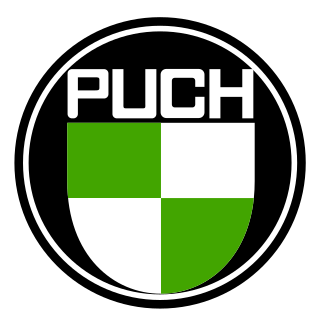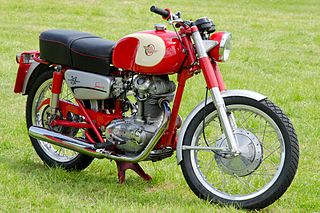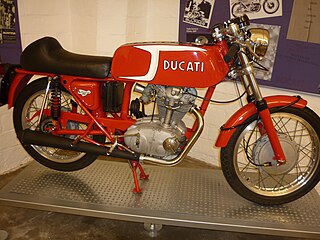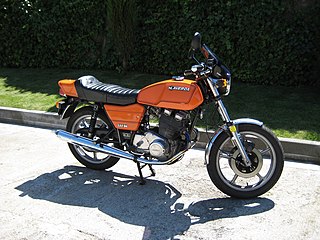
Moto Guzzi is an Italian motorcycle manufacturer and the oldest European manufacturer in continuous motorcycle production.

Puch is a manufacturing company located in Graz, Styria, Austria. The company was founded in 1899 by the industrialist Johann Puch and produced automobiles, bicycles, mopeds, and motorcycles. It was a subsidiary of the large Steyr-Daimler-Puch conglomerate.

A. J. Stevens & Co. Ltd was a British automobile and motorcycle manufacturer in operation from 1909 to 1931. The company was founded by Joe Stevens in Wolverhampton, England. After the firm was sold, the name continued to be used by Matchless, Associated Motorcycles and Norton-Villiers on four-stroke motorcycles until 1969, and since the name's resale in 1974, on lightweight, two-stroke scramblers and today on small-capacity roadsters and cruisers. The company held 117 motorcycle world records.

A motorcycle engine is an engine that powers a motorcycle. Motorcycle engines are typically two-stroke or four-stroke internal combustion engines, but other engine types, such as Wankels and electric motors, have been used.

The Cotton Motor Company, was a British motorcycle manufacturer of 11a Bristol Road, Gloucester, and was founded by Frank Willoughby Cotton in 1918. F.W. presided over the company until his retirement in 1953. The company was reconstituted as E. Cotton (Motorcycles) Ltd, and traded until 1980. The marque was later resurrected in the late 1990s by a business which manufactured replicas of earlier machines.

The Ducati singles were single cylinder motorcycles, made by Ducati from 1950 to 1974. Chief Engineer Fabio Taglioni developed a desmodromic valve system in these years, a system that opens and closes the valves using the camshaft, without the need for valve springs. This valve system has become a trademark feature of Ducati motorcycles.
Rex, Rex Motorcycles, Rex-Acme, was a car and motorcycle company which began in Birmingham, England in 1900. Rex soon merged with a Coventry maker of bicycles and cars named Allard and then later in 1922 the company merged with Coventry's 'Acme' motorcycle company forming 'Rex Acme'. The company existed until 1933, and, in its heyday, was considered one of the greatest names in the British motorcycle industry.
FN is a Belgian company established in 1889 to make arms and ammunition, and from 1901 to 1967 was also a motorcycle manufacturer. FN manufactured one of the world's first four-cylinder motorcycles, was famous for the use of shaft drive in all models from 1903 to 1923, achieved success in sprint and long-distance motorcycle racing, and after 1945, also in motocross.

Beta is an Italian motorcycle manufacturer, specialising in off-road motorcycles. Beta is best known for their popular observed trials bikes. In 2005, they launched a range of enduro motorcycles using KTM engines. In 2010 they launched the new RR series, with a new engine made in-house. Beta motorcycles have been used by world trials champions such as Jordi Tarrés, Dougie Lampkin, Albert Cabestany and Enduro riders Steve Holcombe and Brad Freeman. Production in 2018 was expected to be in excess of 20,000 motorcycles, ranging in size from 50 cc to 480 cc.

Victoria was a bicycle manufacturer in Nürnberg, Germany that made motorcycles from about 1901 until 1966. It should not be confused with a lesser-known, unrelated Victoria Motorcycle Company in Glasgow, Scotland that made motorcycles between 1902 and 1928.

BSA motorcycles were made by the Birmingham Small Arms Company Limited (BSA), which was a major British industrial combine, a group of businesses manufacturing military and sporting firearms; bicycles; motorcycles; cars; buses and bodies; steel; iron castings; hand, power, and machine tools; coal cleaning and handling plants; sintered metals; and hard chrome process.

The Ducati Sebring is a 340 cc (21 cu in) single cylinder bevel drive SOHC motorcycle produced by the Italian manufacturer Ducati from 1965 to 1968. At the time of its introduction it was the largest capacity Ducati machine. Production of the original model ended in 1967 when the 'wide case' Mark 3 was introduced, although just over 200 Sebrings were made in 1968 with the 'wide case' engine. Total production was around 3,500 machines.

The Ducati 350 Mark 3 is a 340 cc (21 cu in) single cylinder bevel drive SOHC motorcycle produced by the Italian manufacturer Ducati from 1968 to 1974. It was one of the first 'wide case' Ducati singles produced. A higher performance version, the Ducati 350 Mark 3D, which used desmodromic valves was also available.
The Ducati 239 Mark 3 is a 239 cc (14.6 cu in) single cylinder bevel drive SOHC motorcycle produced by the Italian manufacturer Ducati in limited quantities for the French market in 1974. The French Government has announced that they were to increase VAT on motorcycles of 240 cc and above in 1975. Ducati responded by producing the 239 to take advantage of the lower 20% VAT rate on sub-240 machines. To compensate for the reduced capacity, the engine was tuned to produce more power with a different camshaft, slipper piston, 30 mm carburettor and a different exhaust using a Lafranconi silencer.

The Ducati 250 Mark 3 is a 249 cc (15.2 cu in) single cylinder bevel drive SOHC motorcycle produced by the Italian manufacturer Ducati from 1967 to 1974. Initially produced using the 'narrow case' engine, the newly introduced 'wide case' engine was used from 1968. A higher performance version, the Ducati 250 Mark 3D, which used desmodromic valves was also available.
The Ducati Diana Mark 3, also known as the Ducati Diana SuperSport and commonly referred to as the Ducati Mark 3, is a 249 cc (15.2 cu in) single cylinder bevel drive SOHC motorcycle produced by the Italian manufacturer Ducati from 1962 to 1966. It was a higher performance version of the Ducati Diana and sold to the American market only. In 1963, Cycle World described it as "the fastest, and nearly the smoothest, standard motorcycle in the 250cc class". It was replaced in 1967 by the Ducati 250 Mark 3.

The Ducati 125 Scrambler is an on/off-road 124 cc (7.6 cu in) single cylinder bevel drive SOHC motorcycle produced by the Italian manufacturer Ducati in 1971 and 1972. Although Ducati had stopped production of the 'narrow case' singles in 1967, the Scrambler used a narrow case engine made by MotoTrans in Spain. The model was not a sales success with less than 200 sold worldwide and was soon taken out of production.

The Ducati 450 Scrambler, also known in the US as the Ducati Jupiter and in Europe as the Ducati 450 SCR is an on/off-road 436 cc (26.6 cu in) single cylinder bevel drive SOHC motorcycle produced by the Italian manufacturer Ducati from 1969 to 1974. Total production was around 11,000 machines.

The Ducati 250 24 Horas is a 247 cc (15.1 cu in) single cylinder bevel drive SOHC motorcycle produced by the Spanish manufacturer MotoTrans, who were licensed by Ducati to produce motorcycles under the Ducati brand name. The model was based on the 'narrow case' Ducati 250 and produced in three series from 1966 to 1974. It was named after Ducati's successes in the 24 hours of Montjuïc endurance races. Around 2,000 machines were produced in total.

The Laverda 350/500 is a series of 345 cc (21.1 cu in) and 497 cc (30.3 cu in) air cooled DOHC 4 stroke parallel twin motorcycles produced by the Italian manufacturer Laverda from 1977 to 1983. The engine was used as the basis of future 650, 650, 668 and 750 cc models. Around 5,000 of these models were produced in total.



















